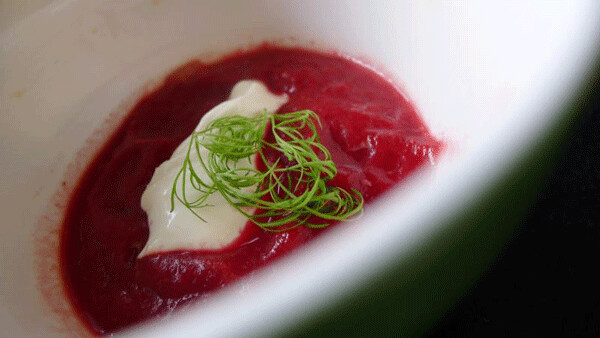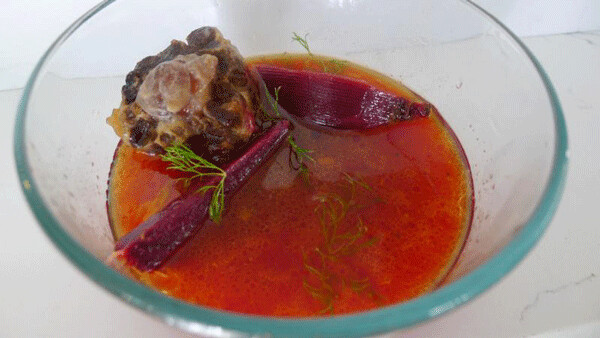A Ukrainian Sour Soup


The long train shuddered through the middle of a cold winter night, somewhere between Mongolia and Siberia. The dining car at the end, half-full of boxes, blaring with techno music, and outfitted with a table of babes playing cards and smoking, didn’t seem like the kind of place where I wanted to throw down with the Russian Mob. And it definitely wasn’t the kind of place where I wanted to eat a bowl of borscht.
I come from a line of Yiddish speaking, Ukrainian peasants, and I know borscht when I see it. Borscht is our word. It refers to a sour soup that needn’t be made with beets. Once upon a time it was made with pickled hogweed. My mom still makes a cabbage borscht with tomatoes and lemon, but the beet version is more common in the motherland.
Our waitress in the dining car had large bones and a demeanor that suggested things would be better if we left. As the cook glared at us from a table outside the galley, we ordered borscht.
She returned a few minutes later with shallow bowls of purple water, in which a few lonely slices of hot dog floated.
Hot dogs in borscht is an actual thing. They call it Moscow-style, and even a good rendition would be disappointing. But this one tasted like it was phoned in, which was appropriate, given we were hurtling across the Gobi desert seven time zones east of the warehouse on the outskirts of Moscow where this whole situation belonged.
She brought the bill and a frown. Twenty five bucks for two bowls of borscht that, according to the menu, should have sold for three dollars apiece. She pointed around the table and explained that in addition to the soup we had to pay to use the silverware, napkins, and other amenities that we typically take for granted when dining out. When we protested, a stocky gentleman came over and mimed a Karate-chop on his thigh. He repeated the word “mafia.” The cook leaned in the door of the kitchen, holding a large knife.
“A tale that begins with a beet will end with the devil” writes Tom Robbins in Jitterbug Perfume, quoting a Ukrainian proverb. “And that is a risk we have to take.”
As we contemplated this borsch ultimatum, we chose the safe route and paid up. We would live to eat borscht another day. Hopefully better borscht than this. And it turns out we did.
The next morning, that mysterious dining car had vanished from the end of the train, and since then I’ve been hankering for justice. It wouldn’t be possible, or advisable, to find those guys and ask for my 25 bucks back, but I can at least get that bad taste out of my mouth with a decent bowl of sour beet soup.
There are so many variations, permutations, methods, materials and regional borscht preferences, and my own version is different every time. Having confidence in the process of soup making, and an understanding of how to incorporate layers of sour, will serve you much better than any one recipe. So my aim is to point you in the right direction and get you started on your path.
Ukrainian Sour Soup
This recipe is more of a process than a set of firm directions. At minimum, you need beets, stock, and some kind of acid like lemon or vinegar. Since I make my own stock, I also need bones, onion, celery, tomato and carrot. If you make the stock the night before, you can whip up a fresh batch of borscht at a moment’s notice.
In most traditional Ukranian borschts beef stock is used, but any type of stock will make a fine rendition, including vegetable, chicken or even pork (which is frowned upon by my mom; old habits die hard). Deer and elk bones make the best stock for borscht, in my opinion, and the closest thing to venison that’s available in stores is lamb or mutton. While pretty much any critter will work, the only requirement is that there be bones, and the cartilage, gristle, tendon and other attached connective tissues. If there isn’t any meat on the bones that’s fine; I like making it with oxtail, which has tons of meat. In the case of veggie stock, make sure and add the onion skins and celery base and all the half-dried ugly aromatics you can, and don’t forget the fungus.
Slowly brown the meaty bones in the center of the oven beneath the broiler, turning them as often as necessary to prevent burning. It should brown, crisp, bubble, maybe even gently sputter. This process should go slowly.
Add the browned bones and pan juices to a kettle, slow cooker, Instant Pot or some other arrangement along those lines. Cook it slowly, until the meat is completely soft and the connective tissue has melted into a thick and creamy gelatin. Scrape as much meat and connective tissue as you wish from the bones. In the case of my oxtail and ribs, I basically stripped it all. Cut this meat as necessary into soup-sized chunks, and return the meat and bones to the pot. Skim fat if you wish. Turn the heat to medium.
Cut your veggies and add them. For a gallon of soup, that would be about three carrots, three stalks of celery, two large tomatoes (in quarters) and one large onion (skin on, cut in half).
While that is heating, peel the beets. I don’t peel many things. Not carrots, potatoes, apples, or almost anything. I even eat mango peels. But I do peel the beets, at least for borscht. I guess I’m a little old fashioned that way.
Season with salt, pepper, garlic powder, and lemon or lime--the juice of 2 or 3 fruits or more, to taste. If I have sauerkraut I may pour in some of the jus. We want many layers of sour. In addition to the beets, lemon, and tomatoes, consider adding vinegar. The dollop of sour cream that is surely coming will add another layer.
While the soup simmers, cut the beets into thick wedges, and add them when the soup tastes right. While the beets cook, continue sipping and seasoning. Mom says it needs sugar, but I like it firmly on the sour side. Sometimes I add a pat of butter. The borscht is ready when the beets are perfectly cooked, soft yet firm. Don’t cook it to the point of disintegration.
I serve my borscht in two ways, sometimes at the same sitting depending on the preferences (and finickiness) of my guests.
For a thin, delicate borscht that focuses attention on the beets, serve a bowl of beet-y red broth with some wedges of beet, and perhaps some meat if using, just beets, meat and broth, garnished with sour cream, a green herb like dill or parsley, and/or shreds or sauerkraut or a slice of sour pickle.
For a thicker version of the same soup, transfer some of each type of vegetable, beets included, from the pot to a blender, along with some of the broth, but none of the meat, and puree. If you’re doing a vegetarian borscht, I would definitely recommend the pureed option because it’s more fulfilling and satisfying. Dare I say meatier.
And I’m just going to through this out there, something that the vegetarians may be especially interested in. If you mix the pureed borscht with a sour lentil soup, it’s absolutely amazing. I call it borschentil. It’s probably the closest I’ll ever get to coining a Yiddish word. More importantly, it’s about as far from that dining car as I can hope to get.
